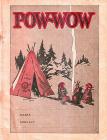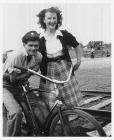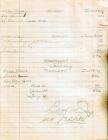14
She kept a meticulous log of her personal banding production in the years 1949 through 1953 - nine scribblers notated in exemplary handwriting. A sample entry taken from Monday, August 29, 1949 reads:Maroon 6" plates 50
saucers 320
green saucers 830
Total 1200
16
Enge loved to read and perhaps it was that unfulfilled wish to be a librarian that surfaced in the form of all this cataloguing. Today the notebooks are an invaluable source of information; an actual record of one person's daily output in detail - the type of ware, the pattern name, the quantity produced, the date of production.Occasionally, the scribblers contained a personal phrase.
"Flo & Bud's Wedding Day" Wed.Aug.10/49
"5 YEARS" Wed.Feb.1/50
"23 years old today" May 18, 1951
"Ernie quit" Sat.Feb.28/53
"N.Y. Yanks World Series Started N.Y. Giants" October 4/51
"Giants 5 - Yanks 1"
17
Garbutt Business College, Medicine Hat, Alberta, Canada20th Century, Circa 1950's
Medicine Hat, Alberta, Canada
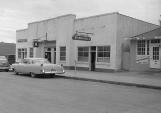 Credits:
Credits:Esplanade Archives, Medicine Hat, Alberta
18
When co-worker Freda Krause moved into the office after finishing secretarial courses at Garbutt's, Enge was asked if she would take the job of banding oval ware. This was a task which had to be performed solely by hand. With the little finger of her brush hand as an anchor along the edge of the ware, she applied the paint as her other hand slowly turned the plate. Given the strain of this type of banding, she would take a break from time to time by painting butter pats. These days Enge displays her little finger somewhat crippled with arthritis and jokingly says she "came by it honestly".19
Enge Stappler 194620th Century, Circa 1946
Medicine Hat, Alberta, Canada
 Credits:
Credits:Rose Marie Woyciehouski
20
It wasn't all work. Despite the meagre wages, life was good. Enge and Margaret eventually moved into a small whitewashed shack, rented at $ 10.00 a month. It wasn't much but it was a place they could call their very own and to which they could invite their friends. It was in that little "chicken coop", as Enge referred to it, that she taught Rose Stickle to dance. She and Rose had become fast friends after meeting in the factory. They sang the song "Sioux City Sue" over and over while they practiced the waltz, the foxtrot and the two-step in the narrow space between the beds.When Enge's sister left the factory to help her brother and his family, Enge moved in with the Stickles. At first, Mr. Stickle may have had some reservations about having such an irrepressible young lady in his household, thinking perhaps of the influence she might have on his own demure daughter. However, Enge's warm personality must have won him over, for she stayed with the family for four years, right up to the day she got married. The Stickles hosted a wedding shower for her in their home and Mr. Stickle acted as the M.C. at the wedding reception which was held upstairs at the old Eagles Hall on Second Street.
22
Enge met her husband at Medalta and it was apparently love at first sight for her. One day at work, a handsome young man passed by what Enge called "the chain gang" (it was actually their work station). His name was Ruben Kessler and she announced to the other girls that he was the man she was going to marry. Ruben, on the other hand, definitely had no plans to get married and considered himself a confirmed bachelor. However, it wasn't long before they were going out together.Enge recalls her first date with Ruben. She was already living with the Stickles and Mr. Stickle gave her a curfew of 10 p.m. It wasn't really that she objected to the time she had to return, but more to the fact that someone was dictating it. After all, she was an independent working girl, earning her own wage. When Ruben brought her home at the end of the evening, Enge had him drive around the block several times so that she would purposely get into the house late.
After what seemed like an eternity to Enge (in actuality, it was about two years), she and Ruben were married in 1950 and remained so for 49 years and 3 months.
23
Enge and co-workers20th Century, Circa 1948
Medalta Potteries Limited, Medicine Hat, Alberta, Canada
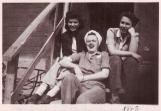
24
Enge continued to work in the Art Department. She enjoyed the atmosphere and the camaraderie and she enjoyed working with Mr. Hulme who preferred to be addressed just as Tom. Enge remembers him as a kind and gentle man who was never rude or scolded his staff and only occasionally "got his shirt in a knot". He would sit in his office, quietly working, with curls of smoke from his ever-present pipe drifting into the air.In the afternoon, he would say "Time for tea" and somebody would swish out the teapot and throw in a tea bag. One day he said "You Canadian girls just don't know how to make a proper cup of tea". So Enge piped up "Tomorrow you're making it".
She lived to regret that remark. The next day Tom made the tea and according to Enge "The tea was jet black! It was bitter! It was so strong you could almost walk on it! It was undrinkable!" It led her to the conclusion that he really didn't know how to make tea either and that his wife was probably the tea maker at home.
26
Enge left Medalta Potteries when she became pregnant with her first daughter, Patti. In her impeccable script, she made her final notebook entry:Thursday, July 2, 1953
Hotel Wales Small Ovides 342
Hat Ashtrays Pink 14 Yellow 14 Turq. 12
Total 382 Last Day at Medalta.
27
Enge Kessler 200820th Century, Circa September 2008
Edmonton, Alberta, Canada
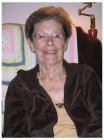 Credits:
Credits:Joyce Yamamoto
